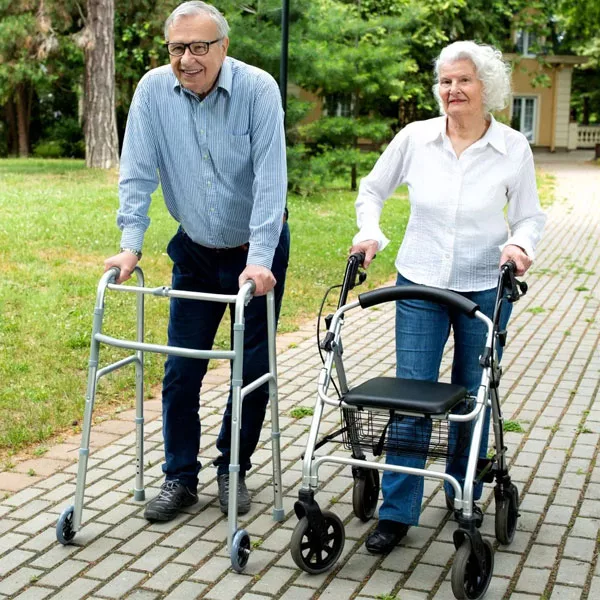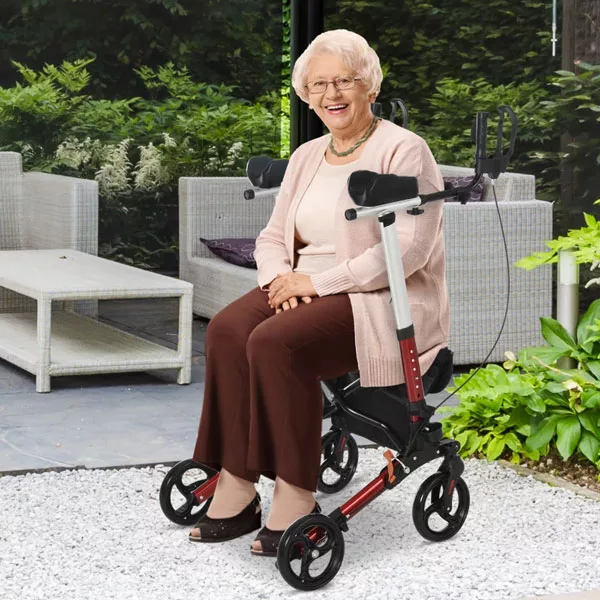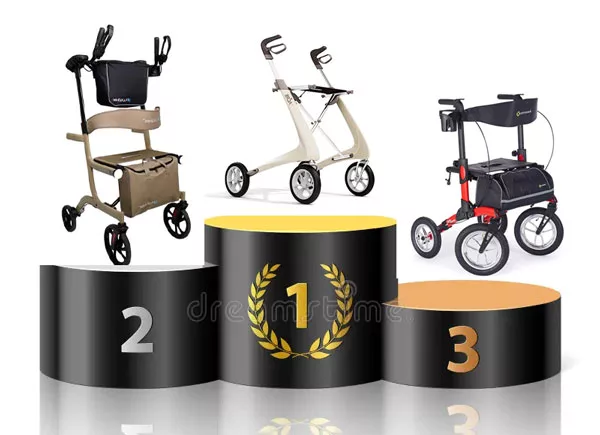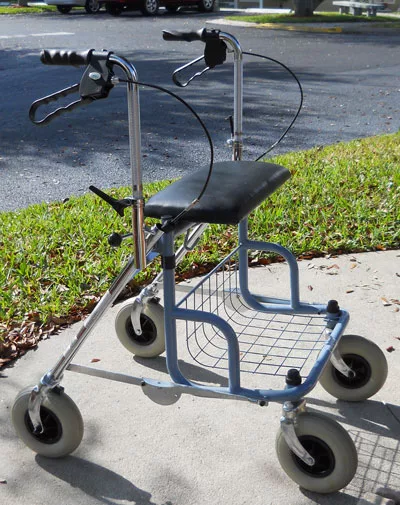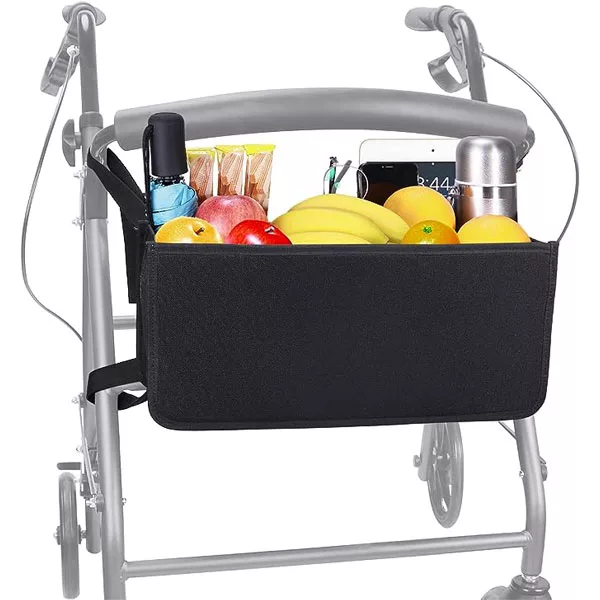Frequently Asked Questions About Walkers for Seniors
General Questions
- What are the different types of walkers available?
- Answer: There are various types of walkers including standard walkers, two-wheel walkers, three-wheel walkers (which have one wheel in front and two in the back for enhanced maneuverability), four-wheel walkers (offering four wheels for added stability), and rollators. Rolling walkers are designed for easy movement and are especially useful in small spaces. Walkers with front wheels are particularly suitable for indoor environments, allowing users to move smoothly without lifting the device. Each serves a unique purpose and is suited for different mobility needs. Traditional walkers are a type of assistive device, as referenced by Webster JB. Ensure the walker handles are adjusted to hip height for proper use to maximize comfort and safety.
- How do I choose the right type of walker?
- Answer: The choice depends on your mobility requirements, lifestyle, and the terrain you’ll be navigating. Consulting a provider for a personalized recommendation is often the best approach. Referencing authoritative guides such as Webster JB can also help you select the most appropriate assistive device.
- What is the average cost of a walker?
- Answer: Prices can vary widely depending on the type and features, ranging from $50 for basic models to $200 or more for advanced rollators.
- Is a prescription needed to get a walker?
- Answer: While not always necessary, a prescription can help you get coverage for your walker. Older adults often benefit from professional guidance when selecting assistive devices.
- Can I rent a walker?
- Answer: Yes, many medical supply stores offer rental options for various types of walkers, including both traditional walkers and rolling walkers. You can compare these to other walkers to find the best fit for your needs.
- How durable are walkers?
- Answer: Most walkers are built to last and can serve you well for several years if maintained properly.
- Do walkers come with warranties?
- Answer: Many reputable brands offer warranties, but it’s always good to check and understand the terms before making a purchase. Four-wheeled rollators typically include handbrakes, a built-in seat, and a storage basket, making them ideal for active seniors who value both functionality and convenience.
- Can I use a walker after surgery?
- Answer: Walkers are often recommended as assistive devices for post-surgery mobility, but always consult your healthcare provider for personalized advice.
- How do I fold my walker for storage or travel?
- Answer: Many walkers are designed to fold easily for storage or travel, and their compact size allows them to fit conveniently in a car’s trunk for transport.
- Answer: Walkers are typically made from aluminum or steel. A light weight design is important for portability and ease of use. Many manufacturers sell models specifically for shorter people and bariatric versions for those over 350 pounds, ensuring a suitable option for a wide range of users.
- Answer: Walkers are typically made from aluminum or steel. A light weight design is important for portability and ease of use.
Types of Walkers
Choosing the right walker is an important step toward safe and comfortable mobility. The main types include standard walkers, rolling walkers, and knee walkers. Standard walkers are the classic option, featuring rubber-tipped legs and requiring the user to lift the walker forward with each step. These provide the most stability and are ideal for those who need maximum support while walking. Rolling walkers, which include two wheel, three wheel, and four wheel walker designs, have wheels on the front or all legs, allowing you to push the walker forward smoothly. A four wheel walker offers excellent stability and often comes with a seat for resting, while a three wheel walker is lighter and easier to maneuver in tight spaces. Knee walkers are a unique mobility aid for those who need to keep weight off one leg, allowing you to rest your knee on a padded platform and propel yourself forward with your other leg. Consulting a physical therapist can help you determine which walker best suits your needs, lifestyle, and walking environment.
Mobility Aid Technical Questions
- Answer: Most walkers come with height-adjustable handles. You can usually find a knob or button on the side of the handle that allows for easy adjustment. Most walkers are height-adjustable within a 5-inch to 10-inch range, ensuring a proper fit for users of different heights.
- Answer: Most walkers come with height-adjustable handles. You can usually find a knob or button on the side of the handle that allows for easy adjustment.
- What are walker accessories and do I need them?
- Answer: Walker accessories can include items like baskets, trays, and cup holders. They can add functionality to your walker but are generally optional.
- How do I clean and maintain my walker?
- Answer: Regular cleaning with mild soap and water, along with periodic checks for wear and tear, will keep your walker in good condition.
- Is assembly required for walkers?
- Answer: Some walkers require minimal assembly, while others come fully assembled. Always check the manufacturer’s guidelines. When assembling, ensure the front legs are properly positioned and secured for safety.
- What is the weight capacity for walkers?
- Answer: Weight capacities vary by model, so it’s crucial to check this before purchasing.
- How do I fold my walker for storage or travel?
- Answer: Most walkers are foldable, but the mechanism can differ. Consult your user manual for specific instructions. A compact, foldable design is especially useful for storing walkers in small spaces.
- Can I add wheels to a standard walker?
- Answer: Some standard walkers allow for the addition of wheels, but it’s best to check with the manufacturer for compatibility. Adding front wheels can convert a standard walker into a wheeled walker, making it easier to move, especially on flat surfaces.
- What materials are walkers made from?
- Answer: Walkers are commonly made from aluminum, steel, or a combination of both, offering a balance of strength and lightweight design. Assistive devices like walkers are engineered to provide durability while remaining easy to handle.
Walker Accessories
Enhancing your walker with the right accessories can make daily life easier and more comfortable. Hand brakes are a must-have for rolling walkers, giving you control over your speed and helping you stop safely. Adding a seat cushion can provide extra support and comfort when you need to rest. Storage baskets are perfect for carrying essentials like your cell phone, keys, or a water bottle, keeping your hands free for support. Non skid soles and rubber tips on the legs of your walker help prevent slipping, especially on smooth floors. Storage accessories like a basket or pouch promote greater independence by allowing seniors to carry personal items. These small additions can make a big difference in your safety and convenience. When choosing accessories, focus on those that improve your comfort, support, and overall experience with your walker.
Maintenance and Care
Keeping your walker in top condition is key to safe and reliable use. Regularly inspect the feet and wheels for signs of wear, and replace them if they become worn down. Lubricate the wheels and moving parts to ensure smooth operation and prevent squeaking. Clean your walker with mild soap and water, avoiding harsh chemicals that could damage the frame. Check the frame and joints for any cracks or loose parts, and address any issues promptly. If you notice anything unusual or feel unsure about a repair, consult a physical therapist or healthcare provider for advice. Proper maintenance not only extends the life of your walker but also helps prevent falls and keeps you walking with confidence.
Safety Tips and Questions
- What are some safety tips for using a walker?
- Answer: Always lock the brakes before sitting, keep your back straight while walking, and ensure the walker’s feet are fully on the ground before taking a step. Step inside the walker before moving forward to maintain proper positioning and balance. Ensuring safe walker use not only protects you but also provides peace of mind for your loved ones.
- Can I use a walker on all types of terrain?
- Answer: Some walkers are better suited for indoor use, while others, like rollators, are more versatile and can be used outdoors. Always check the manufacturer’s guidelines.
- Is it safe to use a walker on stairs?
- Answer: Using a walker on stairs is generally not recommended unless it’s specifically designed for that purpose.
- How do I safely navigate curbs with a walker?
- Answer: Always approach curbs straight on, and use the handles for support as you step up or down. Step up with your strong leg first for stability, and when stepping down, lead with your weak leg to maintain balance.
- What should I do if my walker tips over?
- Answer: If your walker tips over, remain calm and seek assistance to right it and ensure it’s secure before continuing use.
- Are there any age restrictions for using a walker?
- Answer: Walkers are generally designed for adults and seniors, but there are no specific age restrictions.
- How do I safely transition from sitting to standing with a walker?
- Answer: Start from a proper sitting position, use the walker for support, keep your back straight, and push up from the arms of the chair or bed, using your strong leg to help you stand safely.
- Can I use a walker if I have balance issues?
- Answer: Walkers are designed to aid with balance, but consult your healthcare provider
- How do I use a rolling walker safely?
- Answer: When using a rolling walker, always keep both hands on the handles and move at a controlled pace. Use proper technique for moving forward by alternating between your strong leg and the other foot as you walk, ensuring stability and safety.
Common Mistakes to Avoid
Using a walker correctly is essential for your safety and comfort. One common mistake is not adjusting the walker to the right height, which can lead to poor posture and discomfort. Make sure your walker is set so your elbows are slightly bent and your shoulders relaxed when you grip the handles. Another frequent error is stepping forward with the wrong leg—always move your weaker leg forward first when using a walker, followed by your stronger leg. Wearing proper walking shoes with non skid soles is also important to prevent slipping. Avoid overloading your walker with heavy bags or too many accessories, as this can affect your balance. By paying attention to these details, you can use your walker more safely and effectively.
Walker Rental and Purchase Options
When it comes to getting a walker, you have several choices. Walkers are available for purchase or rent from medical supply stores, online retailers, and sometimes through senior services. Renting can be a good option if you only need a walker for a short period, such as after surgery. When buying, consider factors like weight capacity, adjustability, and durability to ensure the walker meets your needs. Consulting a physical therapist can help you select the right model for your mobility and lifestyle. Some insurance plans or Medicare may cover part or all of the cost, so check with your provider about eligibility. Don’t forget to factor in the cost of maintenance and any accessories you might need. With the right research and professional guidance, you can find a walker that supports your independence and well-being.
Lifestyle and Walking Shoes Questions
- Can I travel with my walker?
- Answer: Absolutely! Many walkers are foldable and lightweight, making them easy to transport. A light weight walker is especially convenient for lifting and storing in small spaces, such as a car’s trunk. Just make sure to check the dimensions if you’re flying.
- Is it socially acceptable to use a walker?
- Answer: Of course! Mobility aids like walkers and other assistive devices are widely accepted and can greatly improve your quality of life. They help older adults maintain independence and stay active.
- Can I exercise with a walker?
- Answer: Yes, many people use their walkers to aid in light exercise routines. Always consult your healthcare provider for personalized advice.
- How do walkers impact daily life?
- Answer: Walkers can significantly improve daily life by providing the support needed to perform everyday activities safely. They help older adults maintain mobility and prevent falls, supporting independence and well-being.
- Can I go shopping with my walker?
- Answer: Absolutely, many walkers come with baskets or can be fitted with one. Just be mindful of the weight you’re adding.
- Is a walker or a rollator better for social events?
- Answer: Rollators often have seats and are generally more versatile, making them a popular choice for social events.
- Can I use a walker at home and another for outings?
- Answer: Many people do use different types of walkers for different situations. Some prefer to use other walkers, such as a compact walker for small spaces at home and a rolling walker for outdoor use. It’s all about what makes you most comfortable.
- How do I store my walker when not in use?
- Answer: Most walkers are foldable and can be stored in a closet or corner when not in use. Some even stand upright on their own!
>>> Discover our Top 5 Best Walkers for Seniors in 2023< < <


